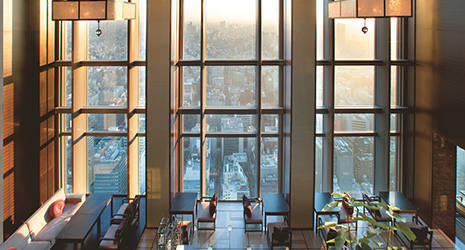Home > Highlighting JAPAN > Highlighting Japan October 2017 > Investing in Japan
Highlighting JAPAN


A Sense of Place
In January 2017, Mandarin Oriental, Tokyo was recognized as the best hotel in Japan in three categories at the TripAdvisor Travellers’ Choice Awards for Hotels, ranking first in Japan in the Top Hotels, Luxury and Best Service classifications. We asked Mandarin Oriental, Tokyo General Manager Paul Jones about the Hotel Group’s strategies in Japan.
What has been the Mandarin Oriental Hotel Group’s historical engagement with Japan and in particular the Nihonbashi district of Tokyo?
Following the establishment of the first Mandarin hotel, in 1963 in Hong Kong, the Group opened further Mandarin Oriental hotels in Asia, and became firmly established as one of the most elegant and luxurious hotel groups. Having grown from its Asian roots into a global brand, the Group now operates thirty hotels and eight residences in twenty countries and territories. Mandarin Oriental hotels and residences are built on the cornerstone philosophy of “Sense of Place,” and created to reflect the very best of the city in which they are located. Mandarin Oriental, Tokyo is the first Mandarin Oriental hotel in Japan. The hotel opened its doors in the Nihonbashi district, the historical and cultural center of Tokyo, in December 2005.
Each Mandarin Oriental destination has its own trademark fan as a symbol of our group philosophy and identity. Ours, created from a colorful Edo-period (1603–1867) print, was crafted for us by Ibasen, which commenced its trade 400 years ago to service the Shogunate in Edo (former name of Tokyo) with its washi (Japanese paper) and bamboo products.
We encourage our guests to experience the many attractions that the Nihonbashi neighborhood has to offer as a significant center for Japanese culture, crafts and cuisine. The hotel team likewise engages with the local community, attending festivals or taking part in traditions such as cleaning the historic Nihonbashi Bridge, for example.
In 2016, we offered an art of dining experience in collaboration with neighboring Mitsui Memorial Art Museum. While the museum was exhibiting the world of Rosanjin [1883–1959], the well-known ceramic artist and epicure, we presented an exclusive menu at our French fine dining restaurant Signature using Japanese ceramic plates produced by artists inspired by the works of Rosanjin. This year, we created a guide introducing Nihonbashi’s countless cultural charms and shopping opportunities to our guests. We also launched a stay package that offers five unique experiences that our guests can enjoy in Nihonbashi such as kimono wearing, or classes in washi paper making and Edo kiriko glass engraving.
What are the principles at work in the hotel’s design?
Creating a distinctive “sense of place” is a core guiding principle of the Mandarin Oriental, Tokyo. While retaining its connection to the city’s past, the ultra-modern Mandarin Oriental, Tokyo also embodies the respect and appreciation Japanese people have traditionally paid to the natural world. Japan is mountainous, heavily forested and run through with many rivers. “Woods and Water” therefore form the underlying design ethos of Mandarin Oriental, Tokyo. The hotel has been conceived as a single large living tree, providing shelter, comfort and a gathering place for the community. Textile designer Reiko Sudo along with countless master artisans and weavers throughout the country have produced original fabrics using natural materials that express the artistic and cultural traditions of Japan in color, pattern and texture. The overall design reflects traditional Japanese aesthetic values such as the importance of understatement and reserve.
Does Mandarin Oriental, Tokyo provide any particular kind of services for its guests that are distinct from Mandarin Hotels in other parts of the world?
Discreet and flawless service underpins the Mandarin Oriental Hotel Group’s mission. Mandarin Oriental, Tokyo combines the spirit of this principle with the ancient Japanese art of omotenashi [hospitality]. Each of our colleagues is passionate, not only about the hotel and our unique place in the Nihonbashi neighborhood, but about Japanese culture in all of its myriad forms and sharing this with our guests in meaningful ways to create delight. During the Edo period, the Tokyo fish market was located in Nihonbashi. Eating sushi in Nihonbashi is thus a true joy for our guests. At the very top of the hotel, Sushi Sora provides a stunning setting, not only for delighting the palate with extraordinary Edomae style sushi but also for savoring the breathtaking views of Tokyo’s skyline.
How is increased tourism affecting your strategy looking forward?
Our most important aim is to continue to offer outstanding and memorable stay and dining experiences for both our hotel guests and our regular Tokyo dining patrons in the true spirit of omotenashi. We offer twelve inimitable restaurants and bars including three Michelin-starred restaurants. Our spa is unique in Tokyo in having been awarded a five-star rating for three consecutive years by Forbes Travel Guide. Nihonbashi today is one of the most exciting places in Tokyo. The urban development initiatives by Mitsui Fudosan have been outstanding bringing many new businesses to Nihonbashi and creating a vibrant atmosphere rich in Japanese heritage, amazing dining and crafts. The collaboration with our neighbors makes the hotel a key part of the community, and we will continue creating opportunities for our guests to enjoy the unique Nihonbashi experience and culture.
© 2009 Cabinet Office, Government of Japan






